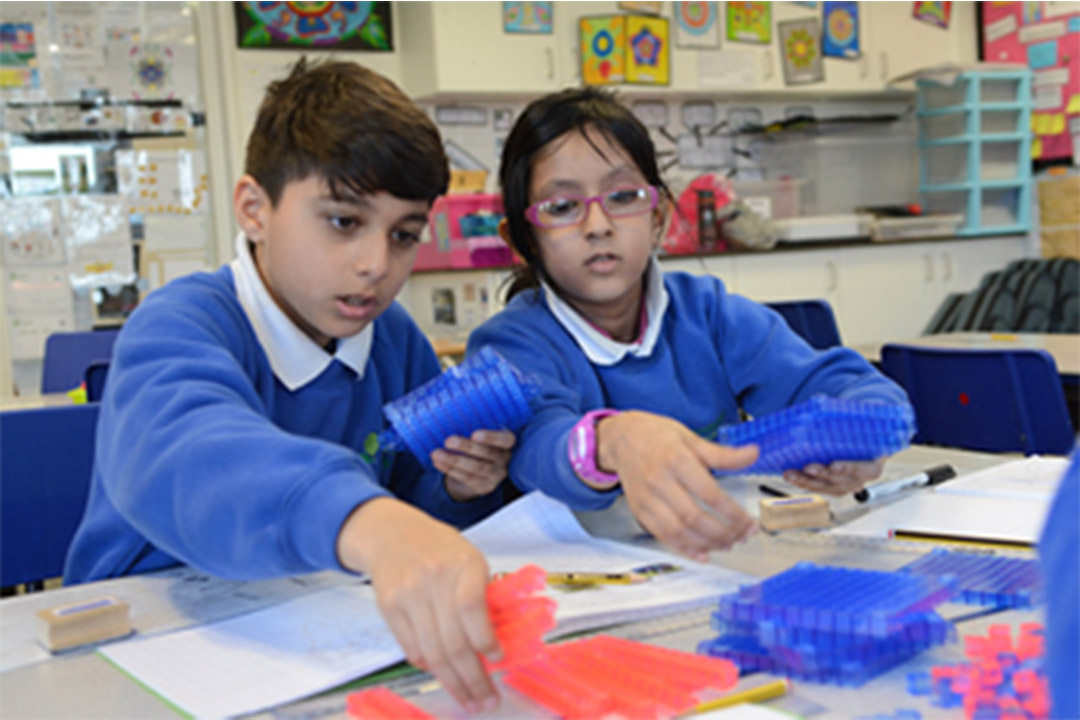School sees better results through teaching for mastery
Embracing teaching for mastery in maths has seen pupils’ love for the subject contribute to some exceptional end of year outcomes for all year groups

Elmhurst’s ethos
With a four-form entry and almost 1,000 pupils, Elmhurst is larger than most primary schools. Around fifty teaching staff are employed, and a passion for maths is important when teachers are appointed. Head of School Sukwinder Samra is clear on her expectations of staff – they need to share her vision that children become happy and confident learners, especially in maths.
Being the lead school for the London North East Maths Hub means that Elmhurst has already been recognised as a centre for excellence in maths, and their own implementation of teaching for mastery.
Teaching for mastery is the way maths is taught to all year groups, so that children experience continuity as they move from one year group to another. As a result of teaching for mastery, the culture of studying maths at Elmhurst includes an ever-present element of exploration.
Children are encouraged to ask questions and it is absolutely ok to get things wrong. The process of learning is transparent and positive. One outcome of this is that there is no anxiety over taking this approach to teaching maths to ‘high stakes’ classes where pupils are preparing for end of key stage tests.
Parental involvement with learning maths means that effective classroom practices can be reinforced at home too, despite the challenge that many parents don’t speak English as their first language and wouldn’t consider themselves confident mathematicians. They can, however, get involved in their children’s study of maths through homework.
One aspect of pupils’ fluency is supported by practising their times tables recall at home on an online times tables learning tool, meaning parents can support and take part in their learning. Back at school, there is regular celebration of the pupils with the best scores and the biggest improvement.
Confident teachers
Having staff who are confident in the delivery of teaching for mastery has underpinned Elmhurst’s success, and significant investment in staff training has been essential. When some of the first cohort of Shanghai teachers visited England in 2014/15 and demonstrated teaching for mastery in maths, all the staff at Elmhurst observed a lesson.
‘Teachers and teaching assistants have to see it’, explains Sukwinder. ‘For staff to develop their own practice, they need to know what great teaching for mastery really looks like in action’.
In addition to seeing the pedagogy, teachers have taken part in CPD to enable them to get the most out of the textbooks and resources they use. While all teachers use the same series of textbooks which support a mastery approach, in-house and external training has meant that teachers feel confident in choosing the activities and tasks best suited to their pupils. Flexibility and consistency are not mutually exclusive, and lessons are carefully planned and tailored to pupils’ needs.
Enthusiastic pupils
Year 4 – rich mathematical discussion

When we visit a Year 4 class to see them learning maths, the pupils’ enthusiasm is infectious. The class are solving word problems using the bar model to represent the problem and a calculation strategy to solve it, and each child has three different-sized pieces of paper in front of them. One pupil explains to me why he has chosen two of the three pieces to represent the problem presented on the board, and what the calculation is that he will do next on his mini whiteboard. As I stand up to visit another table, he ensures I don’t miss out on seeing what his peers are doing, pointing to the other end of his table and telling me, ‘They are having a debate’. They certainly are – two boys are having a lively discussion about which pieces of paper best represent the bar model required, and their reasoning is robust and articulate. When they come to calculate 4388 – 3195, a girl next to them confidently evaluates that she will use the column method, having judged it to be ‘the most efficient’ process.
Looking at work in pupils’ books is as much an exercise in reviewing literacy as numeracy, and the proliferation of written explanations and thoughts is testament to the process being as important as the answer. Prior to calculations, pupils often start with the stem sentence ‘I think that…’ and explain the methods they will use, or the procedure they evaluate to be the most effective.
Year 5 – ‘trying different methods’
When we join Year 5, they are working on 2 × 2 digit multiplication. As with Year 4, evaluation of the efficiency of the approach taken to solve a problem is at the core of what the pupils are doing. They are presented with an image of seats in a stadium to represent the calculation 18 × 24, and embark upon a variety of different ways of addressing it.
Some cut out the images and lay sections of seats on top of each other, investigating congruence. Some opt to work through a calculation on their whiteboard, with pupils using both the expanded and compact multiplication methods to suit their own needs. One girl explains: ‘That’s what maths is all about – trying different methods’.
Class teacher and Maths Coordinator Pinal Sheth keeps the class together while allowing pupils to explore their own ideas. Her aim is that no pupil falls behind; they collaborate in a structured way, as well as working independently when required. Pinal’s planning allows pupils to pursue their own lines of enquiry when working through a calculation, and she works with individual pupils to ensure that their understanding is checked regularly. As with Year 4, books demonstrate pupils’ thinking as well as their calculations. Gone are the days of pages and pages of practice exercises; these have been replaced with real evidence of pupils understanding not only what the answer is, but how and why they have arrived at it.
Planning lessons
During break, we get chance to speak to the teaching teams for Year 3 and Year 4, and get an insight into how they co-plan their maths lessons for maximum impact. While benefiting from their school size, they face the same challenges as any other school -- limited time to spend as a team, a variety of experience, fitting in planning for maths amongst all the other subjects – but prioritise finding time to plan together. Collaboration and professional trust form the basis of their approach, with each teacher taking responsibility for a topic unit and planning a series of lessons which are then shared with the other teachers of the year group.
While one teacher may take the lead, the lessons produced are not ‘fixed’, and teachers are encouraged to offer additional ideas, make changes and adapt the lessons for their classes. The team regularly regroup to dissect the lessons and refine their planning. Accountability for producing shared resources helps ensure the quality: ‘If I’m producing lessons to share, I know I need them to be my best lessons!’ explains Lucy.
The shared approach also means that teachers have the much-needed time to dedicate to carefully planned lessons, and therefore have more scope to be creative. The result is lessons that are achievable for all pupils, that take small steps, and that flow logically, so learning is uninterrupted. Constant mini-plenaries ensure that all pupils keep up, and that a teacher can forensically diagnose any misunderstanding and select the intervention required. Support at break or prior to the next lesson is then put in place, to minimise the risk of any child falling behind.
The teachers are keen to explain how Elmhurst’s attitude to making mistakes is key to their success in maths. They acknowledge that teaching for mastery does not eliminate pupils making mistakes and that addressing these is still part of their pedagogy. The phrase ‘a useful misconception’ is part of each teacher’s lexicon, and all lessons promote learning from mistakes and helping each other to understand. Pupils are taught to differentiate between ‘a good mistake’ and ‘a silly mistake’, and know that mistakes are all part of the process of learning.
It is clear that the way in which the teachers work and learn is the model for their pupils. Collaborating, evaluating and refining, and learning from each other are not only expected of pupils, but are actively expounded by the staff too. Teachers at Elmhurst not only talk the talk but walk the walk, and their results are evidence of that.
Better results
Elmhurst has had several years of successful maths results, but teaching for mastery is now seeing every year group excel. After 2017’s maths results (end of KS2 data saw 89% of pupils at Expected Standard and 40% at Greater Depth), Sukwinder was delighted. Her hopes for 2018 were to maintain this high standard, but because the Year 6 pupils had benefited from several years of teaching for mastery in maths, they exceeded even Sukwinder’s expectations. 41% of pupils achieved Greater Depth, and 97% of pupils met Expected Standard.
Results for both Year 6 and across the school demonstrate several years of commitment to teaching for mastery, and show that Elmhurst’s faith in the approach is well-founded.
| Summer 2018 results | % Expected Standard | % Greater Depth |
| Year 2 (end of KS1) | 84 | 31 |
| Year 6 (end of KS2) | 97 | 41 |
As well as end of key stage data, teacher assessment data at the end of each year is also strong, showing the impact that teaching for mastery is having across the school.
Still learning
Outcomes are exceptional, but the aspirations that staff at Elmhurst have for their pupils mean that they are not stopping there. Sukwinder and her team are continuing to facilitate maths-specific CPD, including a focus on journaling. They have begun to explore this practice, but acknowledge that it is still in its early stages and they have much to learn. A Mastery Specialist from another local primary school is coming to Elmhurst to train teachers on this approach, which encourages pupils to clarify their thinking in writing as part of the learning process in maths, so they can reflect on their own progress and understanding.
Undoubtedly, the pupils at Elmhurst are benefiting from teaching for mastery in maths. And the success staff are seeing at Elmhurst is a spur for the school, in its role leading the London North East Maths Hub, to support others in this part of London along the same road.
Whether your school is looking to get ready for delivering teaching for mastery in maths, has introduced it, or is embedding it, there is support available for you from the NCETM and Maths Hubs. If you are looking for CPD or support from a local Mastery Specialist, contact your local Maths Hub who can help you. If you want to download high quality professional development materials to enable you to develop this approach in your own classroom, we have a wealth of resources available.
This case study was first published in 2018.


